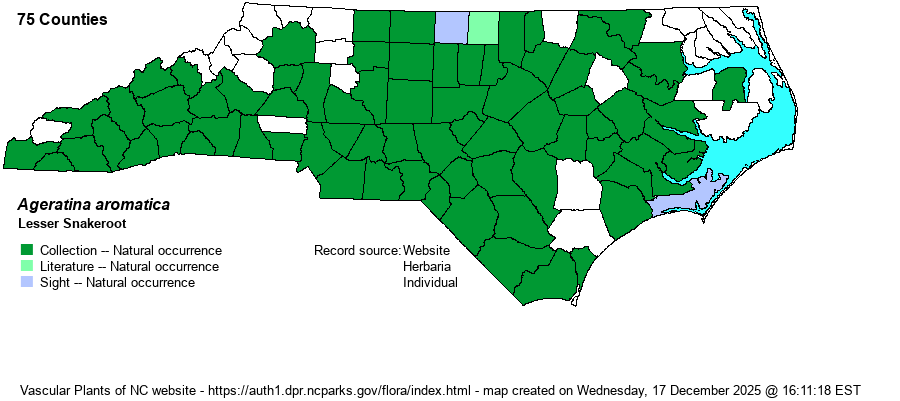| Author | (L.) Spach | |
| Distribution | Essentially throughout the state, but perhaps absent from northern outer Coastal Plain and northern Mountains.
MA to OH, south to northern FL and southeastern LA. | |
| Abundance | Fairly common to common in most of the state, except rare in the northwestern corner, and also rare in the far eastern counties. Generally less common in the Mountains and western Piedmont than is A. altissima. | |
| Habitat | Dry to mesic, occasionally xeric, pine-oak-hickory woodlands, Longleaf Pine--Wiregrass woodlands and savannas, rocky slopes, outcrops, glades, barrens. It is fire-tolerant. | |
| Phenology | Flowering and fruiting August-October. | |
| Identification | Our species of Ageratina can be told from the closely related genus Eupatorium by the greater number of florets per head [12-34 vs. 14 or fewer (most species only 5)]. In the field the heads are brighter white in Ageratina than in any Eupatorium species, a very useful clue. White Snakeroot (A. altissima) is robust, 2-4 feet tall (vs. 1-2.5 feet tall in Lesser Snakeroot), and has larger leaves that are sharply toothed (vs. bluntly toothed or crenate in Lesser Snakeroot). In addition, Lesser Snakeroot has rather thick and shiny leaves and grows in dry to mesic habitats, whereas the other species has thin and dull leaf surfaces and grows mainly in the shade of rich forests. | |
| Taxonomic Comments | Formerly known as Eupatorium aromaticum.
| |
| Other Common Name(s) | Small-leaved White Snakeroot -- a terrible name, as White Snakeroot is typically used for A. altissima. | |
| State Rank | S5 | |
| Global Rank | G5 | |
| State Status | | |
| US Status | | |
| USACE-agcp | | |
| USACE-emp | | |

